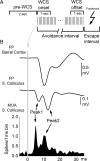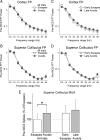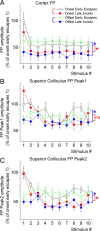Neural correlates of active avoidance behavior in superior colliculus
- PMID: 20573897
- PMCID: PMC2905738
- DOI: 10.1523/JNEUROSCI.1497-10.2010
Neural correlates of active avoidance behavior in superior colliculus
Abstract
Active avoidance of harmful situations seems highly adaptive, but the underlying neural mechanisms are unknown. Rats can effectively use the superior colliculus during active avoidance to detect a salient whisker conditioned stimulus (WCS) that signals an aversive event. Here, we recorded unit and field potential activity in the intermediate layers of the superior colliculus of rats during active avoidance behavior. During the period preceding the onset of the WCS, avoids are associated with a higher firing rate than escapes (unsuccessful avoids), indicating that a prepared superior colliculus is more likely to detect the WCS and lead to an avoid. Moreover, during the WCS, a robust ramping up of the overall firing rate is observed for trials leading to avoids. The firing rate ramping is not caused by shuttling and may serve to drive downstream circuits to avoid. Therefore, a robust neural correlate of active avoidance behavior is found in the superior colliculus, emphasizing its role in the detection of salient sensory signals that require immediate action.
Figures







Similar articles
-
Detection of low salience whisker stimuli requires synergy of tectal and thalamic sensory relays.J Neurosci. 2010 Feb 10;30(6):2245-56. doi: 10.1523/JNEUROSCI.5746-09.2010. J Neurosci. 2010. PMID: 20147551 Free PMC article.
-
Early sensory pathways for detection of fearful conditioned stimuli: tectal and thalamic relays.J Neurosci. 2007 Jul 18;27(29):7762-76. doi: 10.1523/JNEUROSCI.1124-07.2007. J Neurosci. 2007. PMID: 17634370 Free PMC article.
-
Behavioral state dependency of neural activity and sensory (whisker) responses in superior colliculus.J Neurophysiol. 2010 Sep;104(3):1661-72. doi: 10.1152/jn.00340.2010. Epub 2010 Jul 7. J Neurophysiol. 2010. PMID: 20610783 Free PMC article.
-
Unraveling circuits of visual perception and cognition through the superior colliculus.Neuron. 2021 Mar 17;109(6):918-937. doi: 10.1016/j.neuron.2021.01.013. Epub 2021 Feb 5. Neuron. 2021. PMID: 33548173 Free PMC article. Review.
-
Exploring the superior colliculus in vitro.J Neurophysiol. 2009 Nov;102(5):2581-93. doi: 10.1152/jn.00498.2009. Epub 2009 Aug 26. J Neurophysiol. 2009. PMID: 19710376 Free PMC article. Review.
Cited by
-
Integration of visual and whisker signals in rat superior colliculus.Sci Rep. 2018 Nov 6;8(1):16445. doi: 10.1038/s41598-018-34661-8. Sci Rep. 2018. PMID: 30401871 Free PMC article.
-
Laser capture microdissection-capillary zone electrophoresis-tandem mass spectrometry (LCM-CZE-MS/MS) for spatially resolved top-down proteomics: a pilot study of zebrafish brain.Mol Omics. 2022 Feb 21;18(2):112-122. doi: 10.1039/d1mo00335f. Mol Omics. 2022. PMID: 34935839 Free PMC article.
-
Superior colliculus cells sensitive to active touch and texture during whisking.J Neurophysiol. 2011 Jul;106(1):332-46. doi: 10.1152/jn.00072.2011. Epub 2011 Apr 27. J Neurophysiol. 2011. PMID: 21525369 Free PMC article.
-
The Orienting Reflex Reveals Behavioral States Set by Demanding Contexts: Role of the Superior Colliculus.J Neurosci. 2023 Mar 8;43(10):1778-1796. doi: 10.1523/JNEUROSCI.1643-22.2023. Epub 2023 Feb 7. J Neurosci. 2023. PMID: 36750370 Free PMC article.
-
Cortical-subcortical interactions in goal-directed behavior.Physiol Rev. 2023 Jan 1;103(1):347-389. doi: 10.1152/physrev.00048.2021. Epub 2022 Jun 30. Physiol Rev. 2023. PMID: 35771984 Free PMC article. Review.
References
-
- Ahissar E. Temporal-code to rate-code conversion by neuronal phase-locked loops [letter] Neural Comput. 1998;10:597–650. - PubMed
-
- Bandler R, Depaulis A, Vergnes M. Identification of midbrain neurones mediating defensive behaviour in the rat by microinjections of excitatory amino acids. Behav Brain Res. 1985;15:107–119. - PubMed
-
- Boatman JA, Kim JJ. A thalamo-cortico-amygdala pathway mediates auditory fear conditioning in the intact brain. Eur J Neurosci. 2006;24:894–900. - PubMed
-
- Bouton ME. Learning and behavior. Sunderland: Sinauer; 2007.
-
- Brandao ML, Cardoso SH, Melo LL, Motta V, Coimbra NC. Neural substrate of defensive behavior in the midbrain tectum. Neurosci Biobehav Rev. 1994;18:339–346. - PubMed
Publication types
MeSH terms
Grants and funding
LinkOut - more resources
Full Text Sources
